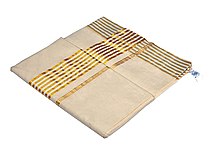| This article is an orphan, as no other articles link to it. Please introduce links to this page from related articles; try the Find link tool for suggestions. (November 2022) |


Chendamangalam Saree is a traditional hand woven cotton sari from Chendamangalam, Ernakulam district of Kerala. This saree is part of the Chendamangalam Handloom tradition of Kerala.
History
This weaving tradition was started by Devanga Chettiar community who were settled at Chendamangalam in the 16th century for Paliath Achan family, the hereditary Prime minister and Raja of the Paliam swaroopam under the Kingdom of Cochin. They started by weaving fine muslin dhotis that could pass ringtest. The handloom tradition flourished into sarees and other fabrics under the nobles of Cochin. The weaving waned by early 20th century as a result of diminishing of patronage. However, through Chendamangalam Handloom Co-operative Society formed in 1954 and The Kerala Co-operative Society Act of 1969 the handloom witnessed revival.
The weavers faced huge losses due to 2018 Kerala floods in the region. The loom regained its glory through collaborative efforts and social participations such as Care 4 Chendamangalam. There was also a unique initiative called Chekutty dolls that was initiated by social entrepreneurs Lakshmi Menon and Gopinath Parayil, which made dolls out of soiled garments that were destroyed by floods in order to raise funds for revival. In 2021 May there was a new collection made for women in law in order to commemorate birth anniversary of first women judge of India Anna Chandy.
Features
It is one among the four famous weaving traditions existing in Kerala today. The saree is distinguished by its puliyilakara (tamarind leaf border), a thin black line that runs abreast with the sari's selvedge. It also has extra-weft chuttikara and stripes and checks of varying width. The saree is a typical Kerala sari and has Kasavu used in it. This sarees are made with high thread count in the range of 80 - 120 and needs two to four days of manual labour.
GI tag
In 2010, the Government of Kerala applied for Geographical Indication for Chendamangalam Dhoties, Sarees/Set Mundu. The Government of India recognized it as a Geographical indication officially since the year 2011.
See also
References
- Sarvaiya, Nupur (25 August 2020). "Save The Loom's weavers give a modern spin to traditional kasavu saris". Vogue India. Retrieved 2021-05-30.
- James, Shalini (2019-12-20). "Read about the regained looms of Chendamangalam". The Hindu. ISSN 0971-751X. Retrieved 2021-05-30.
- "They weave magic to stand on their feet". The New Indian Express. Archived from the original on 2021-06-02. Retrieved 2021-05-30.
- "Kerala floods one month after: Chendamangalam weavers seek new paths to revive handloom sector". The New Indian Express. Archived from the original on 2021-06-02. Retrieved 2021-05-30.
- "Chekutty dolls: How Kerala got its new symbol of hope". The News Minute. 2018-09-12. Retrieved 2021-05-30.
- "Making bedrolls out of PPE scrap! After 'Chekutty dolls', Kerala social entrepreneur Lakshmi Menon embarks on new mission". The Financial Express. 2020-08-27. Retrieved 2021-05-30.
- "Weave for women in law". The New Indian Express. Retrieved 2021-05-30.
- "All you need to know about the simple, classy Kerala kasavu saree". Hindustan Times. 2020-08-31. Retrieved 2021-05-30.
- Alexander, Deepa (2020-09-19). "Chendamangalam sari: a saga of hope and resilience". The Hindu. ISSN 0971-751X. Retrieved 2021-05-30.
- "Details | Geographical Indications | Intellectual Property India". ipindiaservices.gov.in. Retrieved 2021-05-30.
External links
This clothing-related article is a stub. You can help Misplaced Pages by expanding it. |